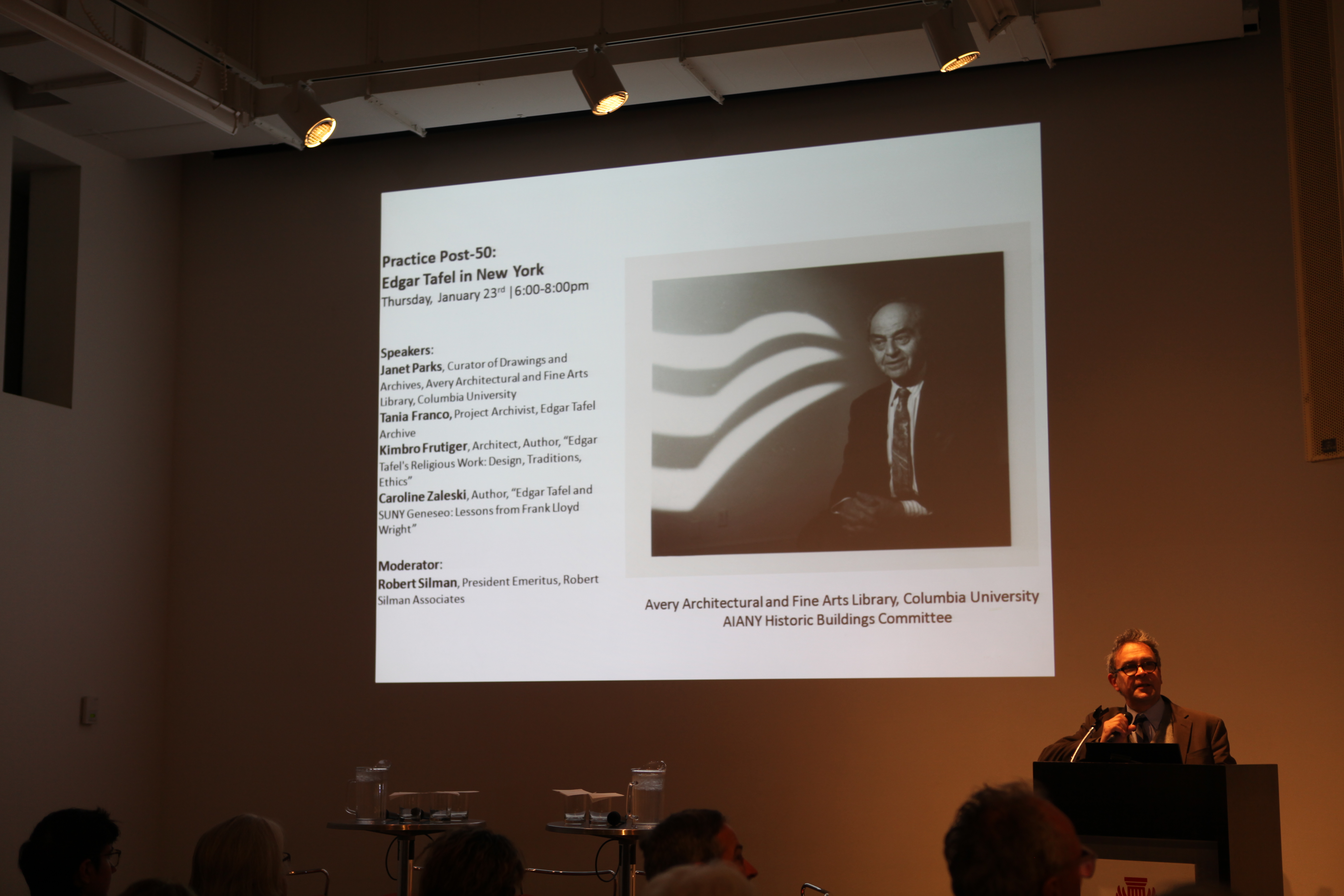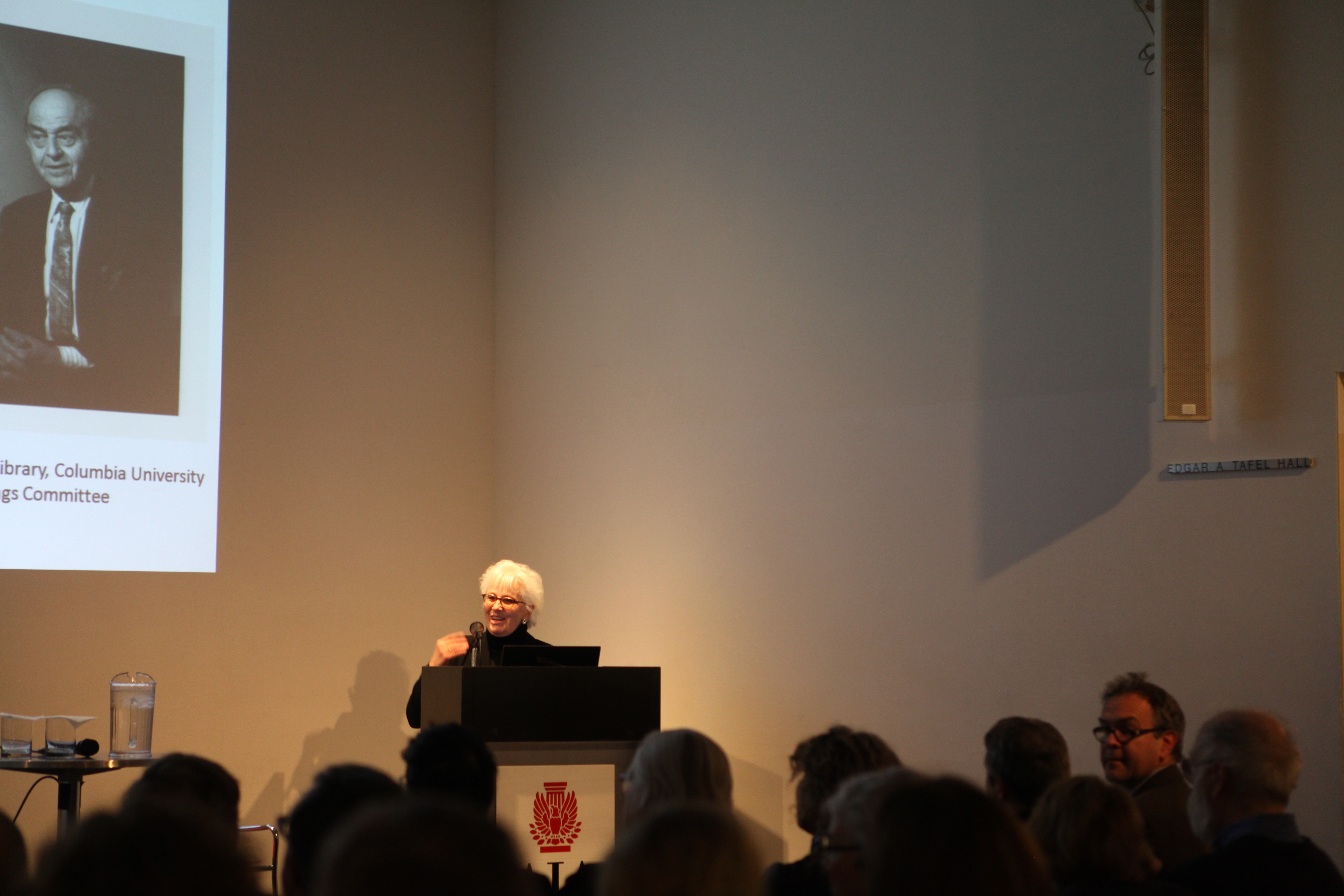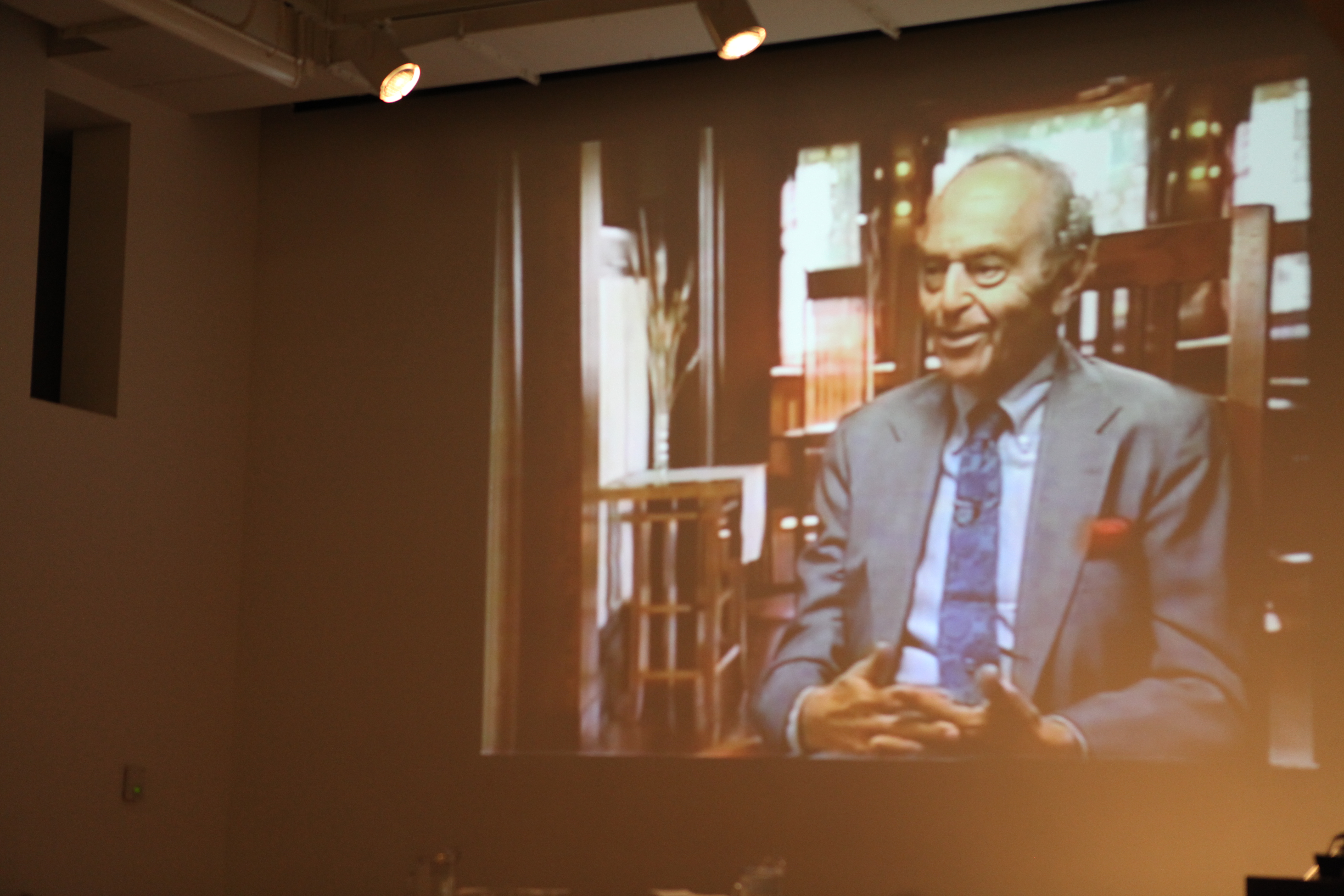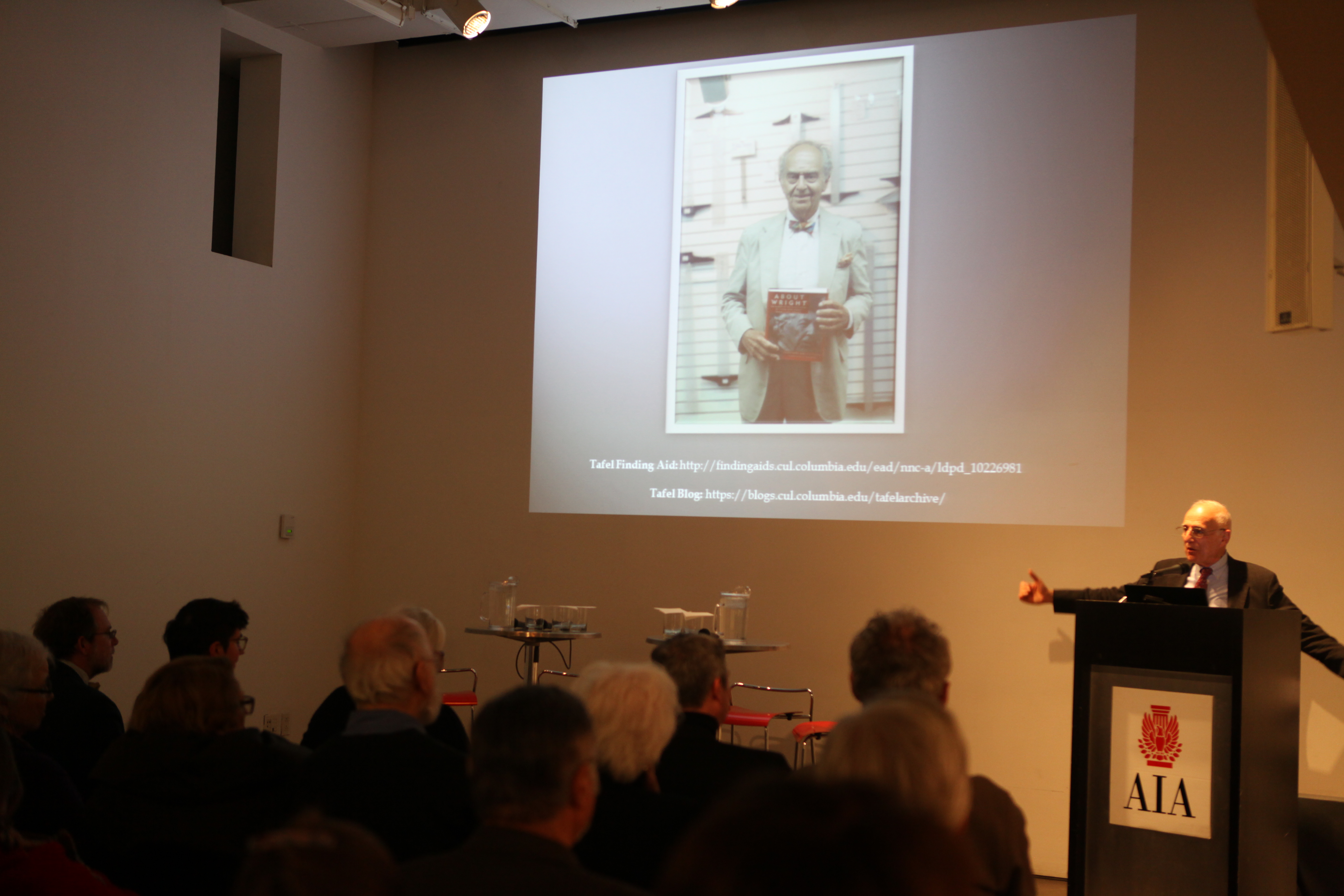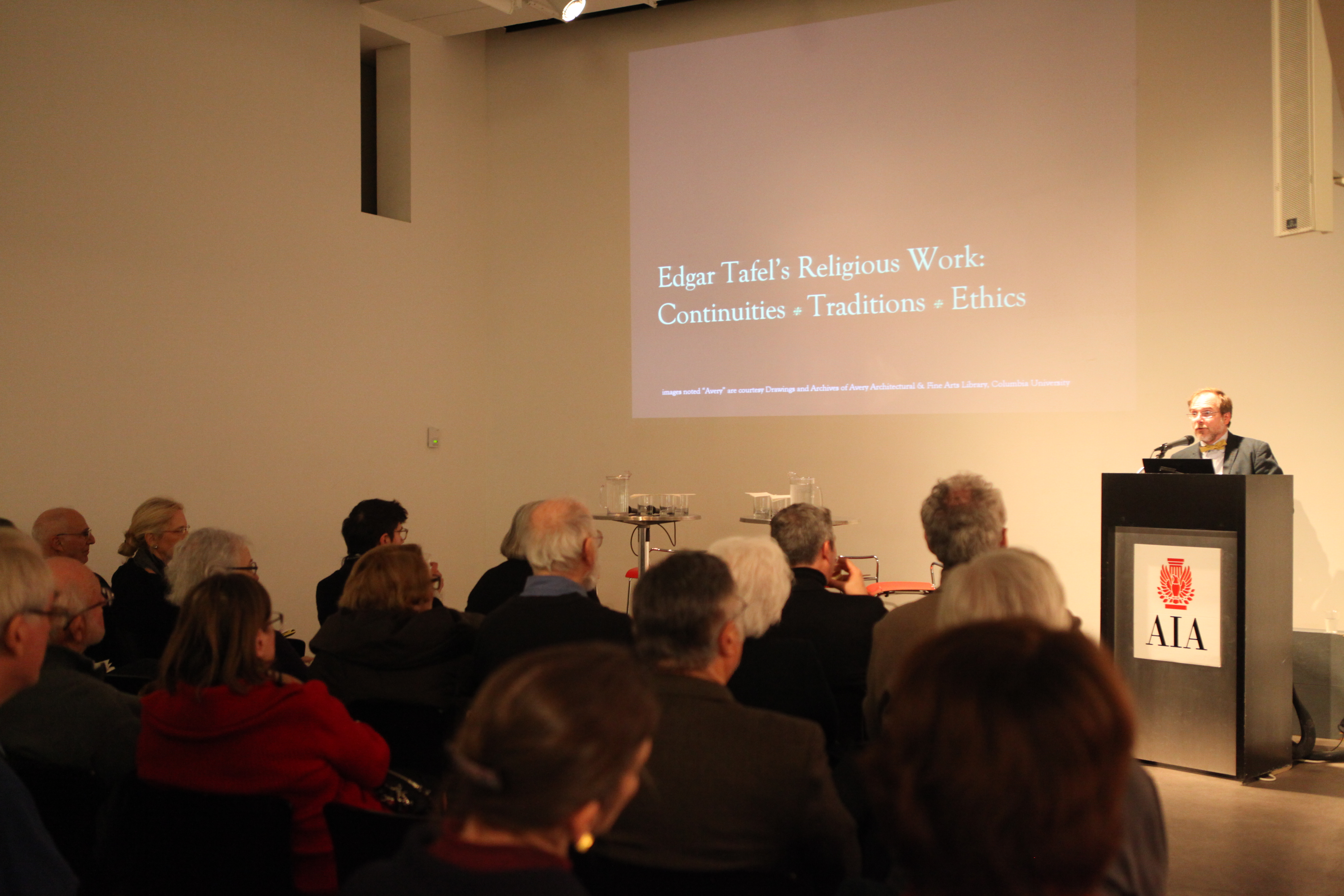by: Bill Millard
Among many stories told at this lively celebration of the later work of Edgar Tafel, FAIA – a natural and engaging raconteur, he was also the subject of quite a few tales over the years – his frequent collaborator Robert Silman related one about the decision to study under Frank Lloyd Wright at Taliesin. Young Tafel had been unimpressed with what he heard as a student in NYU’s architecture program (now defunct) during the 1930s: “These professors don’t know what they’re talking about,” he groused to relatives. Then his aunt saw a newspaper article on the Taliesin Fellowship. What it didn’t say, Silman added, was that “they paid Wright to work for him.” The financial obstacle was considerable, but Wright’s reply to Tafel’s application was something anyone young, talented, ambitious, and shallow-pocketed would want to hear: “Pay what you can, but come.” That exchange, we all now know, changed his life. It also put him, for better or worse, in the orbit of the mentor he would always call “Mr. Wright.” After striking out on his own in 1941 (not without friction, but never with an irreparable break), Tafel contributed distinguished buildings to New York City and other locations, particularly in the religious, academic, residential, and community-service sectors. He worked and lived, Silman noted, with his Wright books constantly open. For the notoriously Manhattan-phobic master, meetings with his old apprentice “Mr. Tafel” may have been the sole unmixed blessing during his stays at the Plaza Hotel. Tafel also developed a second career writing and lecturing about his association with Wright after closing down his solo practice in 1986.
“A part of him never left Taliesin,” Silman commented, raising the unanswerable question of whether the association held him back in certain respects. Tafel’s strong sense of social mission and his delight in bringing quirky, broadly allusive touches to modern buildings on large and small scales add up to a distinctive approach that cannot be reduced to its undeniable chief influence; neither can he be seen apart from it. Tafel, as Caroline Rob Zaleski discussed in thorough detail, brought Wright’s visual language to SUNY Geneseo, where he was involved for a decade in planning that Nelson Rockefeller-era upstate campus (alongside Rolf Myller, Richard Snibbe, and Einar Lindholm), and designing several major buildings. He served as associate-in-charge on the three-winged Fine Arts Building, whose double-height atrium hints at Wright’s Larkin Building (1906-1950) in nearby Buffalo. “I was bothered by an enormous problem of identity,” Zaleski quoted Tafel saying, reluctant either to be wholly overshadowed or to dissociate himself. Wright explicitly spoke of himself as a spiritual second father to Tafel (as to other Fellows), with stronger obligations than mere “blood” parents could claim. With such burdens and benefits intertwined, their combined weight is scarcely imaginable.
Yet the distinctive elements in Tafel’s work, particularly in churches and synagogues, contended Kimbro Frutiger, call for reappraisal and renewed appreciation. Tafel’s willingness to juxtapose historical and local reference points in what Frutiger calls a “rebus of forms” arguably anticipated Postmodernism. One of his important Episcopal churches, St. John’s in the Village (West 11th Street at Waverly Place), is commonly considered a Modernist take on the Greek Revival, but instead strikes Frutiger as “Brutalist Romanesque Orthodox.” In the small-scaled Madison Avenue Methodist Church near Harlem’s Taft Houses, Tafel experimented with fake-mansard roofing, to intriguing effect, long before that form acquired parking-lot fast-food connotations; “awkward is sometimes quite interesting,” Frutiger commented. His likely masterpiece is Church House at First Presbyterian (Fifth Avenue at 12th Street), a home for a progressive religious community and an “anti-Guggenheim… straightforward, but not normative,” where precast panels of quatrefoil ornamentation complicate a façade that visually rhymes with the brickwork and terra cotta of Chicago’s Chapin and Gore Building by Hugh M. G. Garden and Richard Schmidt. Far from being a two-dimensional epigone of Wright, Tafel dared to abandon the organic and weave witty, personal idiosyncrasies with public service.
Tafel’s primary-source archive is now in the hands of Columbia’s Avery Library, which also holds the massive Wright archive in a partnership with the Museum of Modern Art. Janet Parks and Tania Franco described the materials now available for scholars and the public, including a wealth of correspondence and other documents at Avery, with Wright’s models and other three-dimensional materials at MoMA. The labors of untangling and organizing Tafel’s writings and records were formidable, as reflected in Franco’s meta-archiving blog. What emerges is a portrait of an energetic, engaged, complex urban citizen, the product of a progressive upbringing in his youth and a prolific contributor to the architectural literature in his maturity. With Avery serving as a kind of posthumous virtual Taliesin, master and apprentice are now back together. On some level, one would like to imagine that Mr. Wright has made his peace with New York at last.
Bill Millard is a freelance writer and editor whose work has appeared in Oculus, Icon, The Architect’s Newspaper, and other publications.
Event: Practice Post-50: Edgar Tafel in New York
Location: Center for Architecture, 01.23. 14
Speakers: Janet Parks, Curator of Drawings and Archives, Avery Architectural and Fine Arts Library, Columbia University; Tania Franco, Project Archivist, Edgar Tafel Archive; Kimbro Frutiger, Architect, Author, Edgar Tafel’s Religious Work: Design, Traditions, Ethics; Caroline Rob Zaleski, Author, Edgar Tafel and SUNY Geneseo: Lessons from Frank Lloyd Wright; Robert Silman, President Emeritus, Robert Silman Associates (moderator); Carol Ann Fabian, Director, Avery Library (introduction); Rick Bell, FAIA, AIANY Executive Director
Organizers: Avery Architectural and Fine Arts Library, Columbia University and AIANY Historic Buildings Committee









